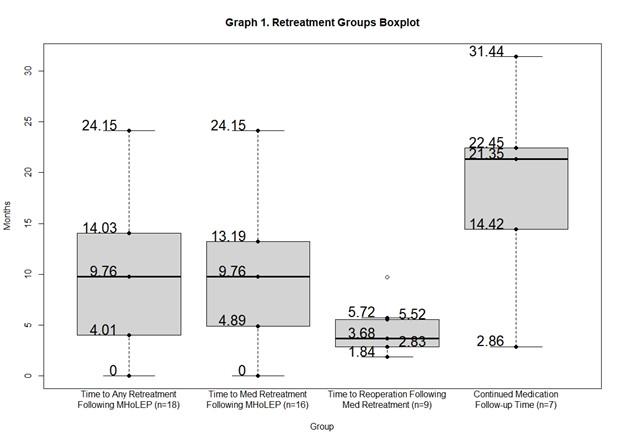Back to 2025 Abstracts
Predicting the Durability of Selective Median Lobe Holmium Laser Enucleation of the Prostate: A Retrospective Cohort Study
Julien DuBois, BSPH, Mursal Gardezi, MD, Jason Lee, MD, Daniel Kellner, MD.
Yale School of Medicine, New Haven, CT, USA.
Background: Holmium laser enucleation of the prostate (HoLEP) is a well-established treatment for benign prostatic hyperplasia (BPH). Selective enucleation of the median lobe (MHoLEP) is a modified approach for patients prioritizing antegrade ejaculation preservation. This study assesses the durability of MHoLEP and identifies factors predicting retreatment risk.
Methods: 113 patients were retrospectively analyzed who underwent MHoLEP by a single high-volume HoLEP surgeon (August 2020-December 2023) with data collected through October 1, 2024. Patients were categorized into durable (no retreatment), medication retreatment, and reoperation groups. Analyses were performed using R 4.4.1.
Results: Median follow-up was 26.5 months. Patients requiring continued medication retreatment at study end had a higher median comorbidity index (CCI) compared to the durable group (6 vs. 3, P=0.028). Reoperations occurred in 9.7% of cases, with necessary retreatment evident at a median of 9.8 months and average reoperation occurring 3.7 months later. Competing risks survival analysis identified CCI as a significant predictor of medication retreatment (HR: 1.76, P<0.001), but limited sample sizes precluded definitive conclusions. Two reoperation patients underwent direct reoperation without intermediate medication retreatment (5 days and 22.2 months post-op).
Conclusions: The vast majority of MHoLEPs were durable making MHoLEP is a viable alternative for patients prioritizing antegrade ejaculation. Reoperations occurred more frequently than traditional HoLEP but comparable to transurethral resection of the prostate (TURP) operations. Elevated CCI correlated with increased likelihood of medication retreatment, highlighting the potential role of preoperative comorbidity assessment in patient selection. Larger studies are needed to validate these findings.


Back to 2025 Abstracts

